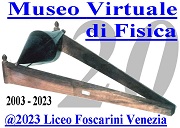
Note sul copyright
Pagina Facebook
Firma anche tu il
REGISTRO VISITATORI
(GUEST BOOK)
 Note sul copyright Pagina Facebook Firma anche tu il REGISTRO VISITATORI (GUEST BOOK) |
General information - The Physics Lab |
|---|---|
| The Marco Foscarini Physics Lab | |
| Galleria d'immagini |

|
| Astatic galvanometer Bottiglie di Leida Oersted's device Hydrostatic balance Tool for the vectorial composition Mechanical paradox (doubble cone) |
The "Ancient Physics Lab" section is truly extraordinary. In fact it houses wide and precious collection of scientific tools, dating from the end of the 1700's to the beginning of the 1900's (up to 1929), which rivals those of the universities. A few of the tools in this collection were selected for the 1994 exhibition "A nineteenth century Physics Lab in Venice" which was held in the School Library.
It's important to specify that there isn't a clear line of demarcation between the Modern and the Ancient Physics Lab. After an analysis of all the instruments, considering the method of construction and also the growing number of industrial tools available rather than exclusively hand made devices, it was decided (Malfi, 2003) to consider as belonging to the Modern Physics Lab all the instruments bought after 1930. From this year in fact the cataloging procedure was completely changed. It is however clear that this is a personal choice and for this reason not definitive.
All the devices of the XIX century belonging to this section (in which didactic use is linked with the artistic taste of the manufacturers) were produced, except for a small group, by expert artisans under commission by the teaching staff of the High School since 1807. This meant valid help was offered to the students in the comprehension of numerous physical phenomena thanks to the practical experiments which could be carried out with these instruments in the Old Physics Lab (currently the School Hall). But at the same time the School Physics Lab was continuing to expand and update its collection of tools, always taking into consideration new discoveries principally in the fiels of electromagnetism. The school has on occasion made notable scientific investments as in the case, for example, of the purchase (1832) from the inventor, professor Nobili, of one of his revolutionary astatic galvanometers.
These tools are between one and two century old, but this does not mean that we are dealing with pieces to be kept in a showcase and good only for an exhibition. All the devices, with few exceptions, are in a perfect state of conservation and a lot are working perfectly, so same instruments are still used during practical physics lessons. For example in the electrostatic experiments in laboratory golden-leaf-electroscopes are used (which have about 150 years of honoured service), various tools for studying the most significant electrostatic phenomena (like the Leyda jars, the Faraday cage, devices for the demonstration of electrostatic induction and regarding the distribution of charges on the surfaces of conductors, points for the realization of the so-called "electric wind"). All these tools are loaded by an old electrostatic machine almost a century old.
In the same way for the stady of electromagnetic phenomena magnetized needles, natural magnets, a device to reproduce the Oersted experiment and a particular electric direct current engine (built by Francesco Cobres) are used. And for example the field lines of the magnetic field which surrounds a coil or a solenoid made with a wire with direct current inside are demonstrated using iron powder as Faraday did in his experiments.
Two hydrostatic scales dated 1818 show the Archimedean principle in a simple, but at the same time very effective way from a didactical point of view. And to show the so-called “parallelogram of forces” (the rule of vectors composition) a tool in wood built between 1857 and 1876 is used. Then of remarkable visual effect is the so-called "mechanical paradox" apparatus, a simple but ingenious tool built before 1818 for the verification of the theorem of the motion of mass centre. This device, which was chosen as the logo for the virtual museum, never ceases to astonish every year both the middle school students during guided visits of the Ancient Physics Lab and our students in physics laboratory lessons.
| Last updated 20-7-2023 | The green words are "work in progress" links. The red / red words are links to italian pages, while the normal ones follow the standard colours. The elements in red have hidden texts actived by the mouse's arrow. The brown links are used to view an immage in the gallery connected with the text. |  |
| The total or partial reproduction of this page and/or of its parts with any means is permitted only if it is not for commercial gain and all authors and Marco Foscarini School must be fully acknowledged. In the case of works on the web a link to the page or pages of the Virtual Museum or of the A. M. Traversi Physics Museum used as source must be always added. The reproduction of any picture from this page in scientific journals and/or in research papers as the publication of this page and of any data of the database need the written authorization of the Traversi Museum Direction. This authorization might be given by the Museum Direction after the presentation of a request in which the project is described. All the technical information regarding the instruments described in the virtual museum are continuously up to date. So differences between page on the web and the last data acquired can be possible. The interested are kindly request to contact the Direction of the Museum. | ||
| URL of the Virtual Museum: http://museo.liceofoscarini.it/virtuale/index.html URL of "A. M. Traversi Physics Museum": http://museo.liceofoscarini.it/museoreale/index.html; e-mail: museo.atraversi@del@liceofoscarini.it [Please delete "del@"]. | ||
| Liceo Classico "Marco Foscarini" - Venezia |